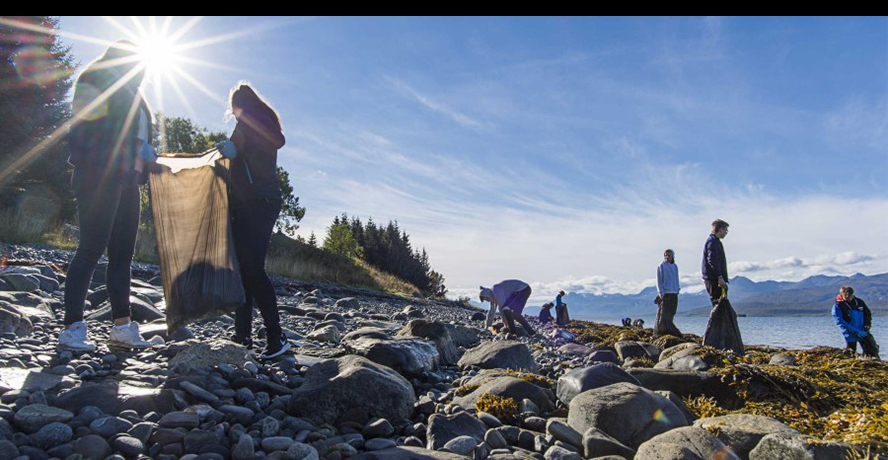
The fact that sustainability is incorporated into every detail
of our expeditions means that YOU ARE CHOOSING
RESPONSIBLE TRAVEL WHEN YOU CHOOSE HURTIGRUTEN.
Being the world leader in exploration travel — and the world’s largest expedition cruise company — comes with great responsibility. With the U.N. Sustainable Development Goals as a framework, and a company mission focused on innovation, technology, and concrete measures, sustainability is inherent in every detail of a Hurtigruten expedition.
As we enter a new era of expedition cruising and adventure travel driven by sustainability, Hurtigruten aims to raise and set standards for the entire cruise industry.
Hurtigruten’s overall business and operations reflect many of the United Nations Sustainable Development Goals, adopted by all U.N. Member States in 2015. Our sustainability ambitions are directly linked to goals regarding responsible consumption and production, climate action, life below water, and more. This is why core to Hurtigruten’s mission is to not only have a positive impact on the cruise industry but on society as a whole.
Hurtigruten’s sustainability focus has many facets, including leaving a smaller footprint:
Download the 24-page Leaving a Smaller Footprint |
Being Green
Minimizing the impact of ship, crew, and guests on the environment:
- Using hybrid engines to move quietly in wildlife environments.
- Using wool textiles.
- Designing food planning and preparation to minimize food waste.
- Working on reducing waste, stopping littering and contributing in clean-ups.
- Plastic, pollution, and cleaner oceans: Plastic pollution is the single largest threat to our oceans. By 2050 there will be more plastic waste than fish in the sea. Hurtigruten is determined to stop the trend — and was the first global travel company to ban single-use plastic.
Fifteen (15) metric tons of plastic ends in the world oceans every minute of the day. If the trend continues, this number will double in the next 10 years. This means that by 2050 there will be more plastic than fish in the oceans.
 “Plastic pollution is the single biggest threat our oceans. Hurtigruten operates in some of the most vulnerable areas in the world. This means that we carry a special responsibility to protect these areas for the local population and future generations of explorers,” Hurtigruten CEO Daniel Skjeldam (at left) says.
“Plastic pollution is the single biggest threat our oceans. Hurtigruten operates in some of the most vulnerable areas in the world. This means that we carry a special responsibility to protect these areas for the local population and future generations of explorers,” Hurtigruten CEO Daniel Skjeldam (at left) says.

Hurtigruten guests and crew frequently clean beaches of plastic pollution and marine litter in remote and pristine areas. Since July of 2018 Hurtigruten has imposed a ban on all unnecessary single use plastic on all of the company’s ships. Hurtigruten CEO Daniel Skjeldam is hoping others will follow.
SUSTAINING SOCIO-CULTURAL RESOURCES
As the largest expedition cruise company in the world and the most important player in both the Arctic and Antarctica, we take the responsibility to lead by example and move the industry, and world, forward.
Supporting preservation of local culture and customs — and the year-round prosperity and long-term development of all the places Hurtigruten visits — are a way to ensure sustainable use of vulnerable areas and authentic experiences. For instance:
- Respecting and supporting indigenous communities.
- Valuing culture and traditions, and maintaining a close cooperation with communities wherever Hurtigruten operates.
- Working to prevent the exploitation and degradation of sites, nature, and local communities by mass tourism.
- Ensuring that any impact left by both guests and crew is only minor and transitory.
- Not leaving visible or lasting signs from a visit.
- Observing wild animals at a distance so as not to alter natural behavior with the utmost respect for their welfare and habitat.
Supporting local economies and contributing to the livelihoods and welfare of small coastal societies is part of our DNA. Things we do, for instance:
- Trading for food and supplies locally.
- Employing local people whenever possible.
- Buying services like excursions from local suppliers
Hurtigruten cruise ships minimize Carbon emissions through nearly 30 different savings measures. For instance:
- Designing and operating hybrid electric (batteries circled) as well as natural gas engines.
- The water used to cool the engines delivers heat back to the ship through an exchange, supplying the galley, showers, ventilation systems, and pool. Additional heat is supplied from the hot water boilers’ exhaust gas.
- Ensuring regular, professional maintenance to reduce fuel consumption.
- Taking regular deliveries from local suppliers where possible to reduce transport, food storage, and onboard food waste
- Optimizing itineraries and routes for most efficient operation.
- Installing new propellers to reduce Carbon Dioxide emissions
The human factor: providing a diversified and safe work environment — While Hurtigruten works to enhance the destinations we visit, we also continously strive to enhance our own organization. We are absolutely certain that a diversified working environment is essential for us to succeed.
- Zero tolerance for gender-based discrimination. 44 percent of Hurtigruten manager level employees are women. They work to ensure women’s full participation at all levels throughout our company, and are eagerly waiting for our first female captain to be appointed — as one of many in Hurtigruten's future.
- Hurtigruten expects all partners and companies to respect equality and give everyone the same opportunity to succeed.